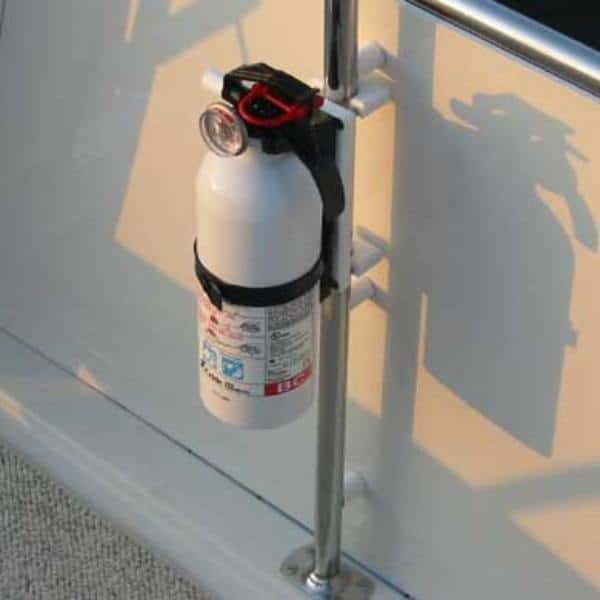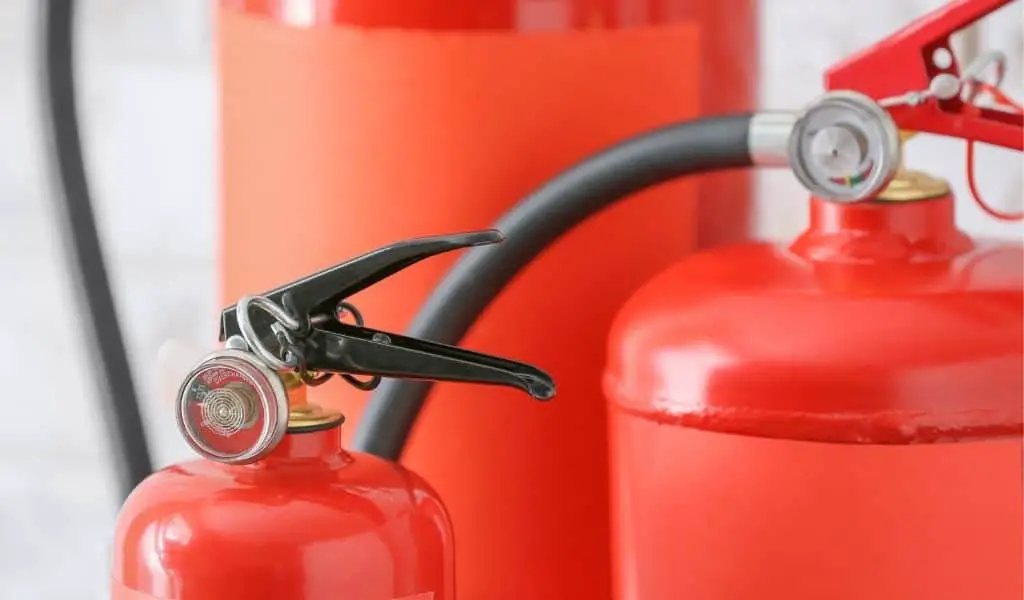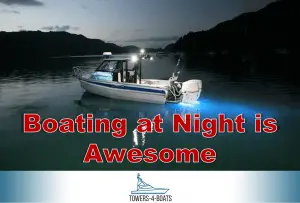While being on your boat is a time for relaxation, to stay fire safe it is important to follow all the safety rules and regulations set by the U.S. Coast Guard, your state and the ones you set based on personal needs. Doing so will ensure that your friends and relatives are safe any time you are on the water.
While the U.S. Coast Guard requires at least one B-1 marine fire extinguisher on your boat, many boat safety sites recommend at least two fire extinguishers onboard before traveling. The size of the fire extinguishers depends mainly on the size of your vessel, and it is a good idea to have extras. In case of a fire outbreak, an extra extinguisher or two can potentially save lives and property on board. I put together a comprehensive guide on marine fire extinguishers that’s a great resource.
So where and how should they be stored? And what types to get in the first place? Here are our best tips to be fire-safe.
Recommended Extinguisher for boats: First Alert Marine Fire Extinguisher
Getting the Right Extinguisher
Fire extinguishers are rated by letters based on their composition and the types of fire they are best used for. The ratings are A, B, C, D and K, all inscribed on the side of the tank. These letters identify the classifications of fires that the extinguisher can put out.
Not all fire outbreak is the same, so it’s important to have a good understanding where and how the fire started and the type of fuel it consumes so it can be eliminated using the right components. So, if a fire starts with flammable liquids such as paint or petroleum, trying to stop it with water will do more harm than good.
Let’s take a look at the types of fires (and extinguishers) you can have on your vessel.
- Class A: The letter A stands for ‘Ash’ and it’s used for ordinary combustible materials, such as wood, fabric or trash. Class A fires can be controlled by pouring water or mixture of water and detergent (foam) on it. These are the most common fire outbreaks you are likely to experience on your boat, mostly due to sparks close to wooden beams, sails or leftover trash. They can be controlled with water, stamped or smothered before they get out of hand.
- Class B: B stands for ‘Barrell’ so think flammable liquids or gasses, such as oil, paint, gasoline and petroleum. They can be dangerous and spread quickly, especially if the container fueling them are aboard the boat in large quantities. As noted above, don’t try to control this with water. This is because burning grease is hotter than the boiling point of water. When water is placed on grease, it creates steam which expands rapidly and splatters, causing burns and spreading the fire. The Class B extinguisher use dry chemicals in the form of foam or powder, like highly pressurized carbon dioxide, halogenated agents, or ammonium phosphate. You can use any of these for flammable liquid-fueled fires, but for fires caused by flammable gasses, only use dry chemical extinguishers.
- Class C: The letter C stands for ‘Current’, so these fires are caused by electrical equipment. Class C extinguishers use dry chemicals or carbon dioxide. Once the electrical item is removed, the fire changes class, so if it is safe to do so (fire notwithstanding), remove it and use an extinguisher appropriate for the material on fire.
- Class D: D stands for ‘dynamite’ and it’s a type of fire characterized by the presence of burning metals. Only certain metals are flammable and the most common Class D fires involve magnesium and titanium. These extinguishers use dry chemicals, but as these fires are most likely in laboratories, warehouses and factories, you are unlikely to need it on your boat.
- Class K: The letter K stands for ‘Kitchen’ and this type of fire outbreak starts with cooking oils, vegetable fats, animal fats and grease. It is dangerous as it can quickly spread and even cause a fire explosion. These fires are technically part of Class B fires and the same type of extinguishers can be used.
Coast Guard Approved 5 Pound ABC Dry Chemical Fire Extinguisher
Minimum Requirements
It’s not only important to have the right extinguishers onboard, but to ensure that you meet minimum requirements for your vessel. If you have a boat smaller than 26 feet, it is recommended to have at least one B-1 fire extinguisher onboard. If your boat is between 26 and 40 feet, you will need at least two B-1 fire extinguishers. If your boat has a U.S. Coast Guard accepted fire extinguishers system installed within the engine compartment, the fire extinguishers number may be reduced.
If you have one of the below features or factors present on your boat, it is important to have a U.S.C.G. accepted fire extinguisher on your boat at all times.
- Enclosed engine compartments
- Completely installed fuel tanks
- Seat compartments used to store engine tanks
- Enclosed areas for cooking and residential purposes
- Fuel tanks that are heavy to move or lift
- Double bottoms which are not permanently sealed to the hull
- Seat compartments where engine tanks might be stored
- Other regions not filled with flotation materials and devices.
The best alternatives for boats of different sizes is to have a tri-class fire extinguisher onboard. These use a dry chemical called monoammonium phosphate, a non-toxic agent that stops the fire’s chemical reaction and inhibits reigniting in class A, B or C fires. While the Coast Guard requires minimum of one, it is good to have two or three tri-class extinguishers to be completely prepared.
This video shows how to properly use a fire extinguisher and save your boat from any onboard fires.
Storage and Maintenance
Experts recommend storing your fire extinguishers in an upright position and mounted in an easily accessible place. You should keep them in rooms where fires are more likely to break out such as the hull, cabin, kitchen and bilge.
Depending on your boat type, it is crucial to have a fire extinguisher available at high traffic areas, where people are likely to gather. Place extinguishers by the exit of these areas and dry chemical or tri-class extinguishers near the source of any fire risk.

Placing the extinguishers in the right places is very important. You can use the fire triangle guide, or take a look at these questions to get you started:
- Where is the location of the gas tank?
- Where do people gather while on the boat?
- How often is the boat cleaned from trash and other debris?
- Where the kitchen is located and is it kept clean regular?
- Where are flammable liquids such as gasoline stored on the boat?
These questions should provide some insight into the number of fire extinguishers you will need on board and the best location to keep them. If there are flammable liquids stored somewhere, make sure to place one of your extinguishers there. Ensure that the kitchen is kept clean, get rid of oil spills, trash and other debris that can catalyze a potential fire outbreak. Be vigilant of the “danger zones”, the most crowded areas on your boat where there is a high probability of fire outbreak. Think of other areas on your boat where risk factors might be present and always place a fire extinguisher in these locations as well.
Try not to store your extinguishers horizontally. The chemical powder used for controlling fire can become compacted at the base of the container, depending on the time it is left without use, so at time of need you may only have access to the discharging propellant and not the extinguishing agent immediately.
Standard fire extinguisher maintenance requires boaters to check their extinguishers every month to ensure they function properly, ready to use at any time. Guidelines and information on how to do this can be found directly on the extinguisher label. Always check the seals and hoses to confirm if there is any damage to the fire extinguisher and weight the container to check if it meets the weight requirement described on the label.
Want to know how long a fire extinguisher good for? Read my article.
Using Your Fire Extinguisher
While having a fire on your boat is a scary idea, being prepared, knowing where the extinguishers are and which one to use can save person and property from the flames. When faced with fire onboard, remember P.A.S.S.
- Pull the pin on the Extinguisher
- Aim the hose or nozzle at the bottom of the fore from the safest and secure distance (as indicated in the operational guide)
- Squeeze the operating level to eject the extinguishing liquid
- Sweep the hose or nozzle from one side to the other; this will provide full coverage until the fire stops.
Now that you are aware of the safety precautions on how and where to store fire extinguishers, which ones to have and how to use them effectively, you can rest assured that your boat is safe. And don’t forget that the best way to avoid fire damage is to do everything to prevent it.




